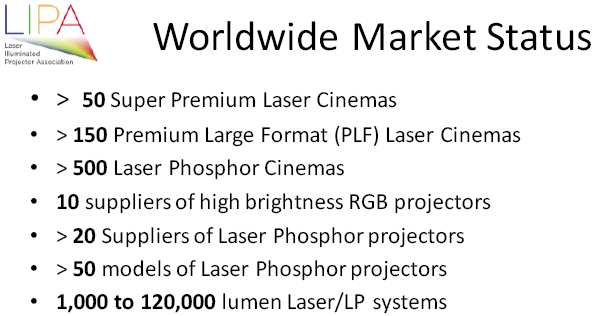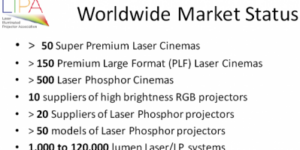
Bill Beck was wearing his hat as a representative of the Laser Illuminated Projector Association (LIPA). It is the fifth anniversary of LIPA and he covered the association and its development.
In the 1970s, laser was seen as dangerous because of laser light shows, so they were regulated. However, lasers in projectors are different and that is why the association is called the Laser Illuminated Projector Association. Digital projection in cinema was a key development. Barco, Sony, Christie, IMax and Disney were the founder members and there were four missions:
- Be a single voice for regulatory reform
- Provide a forum for discussion and consensus building
- Educate key industry stakeholders and the market
- Develop and promote “Best practices” for the industry
Early successes included showing that LIPs were no more dangerous than Xenon-lamp-based systems. There has been some simplification of the FDA variance and simplification of the work around the world.
Two IEC standards have been updated for LIPs (60825-1:2014 and 62471-5), and that has made it better to get consistent regulations around the world.
There is a two year project to develop and agree metrology of laser speckle. Recommendations have been made and a seminar held in March of this year.
In the US, an FDA-CDRG “laser notice” is being developed and the aim is to get the FDA to accept the IEC regulations, but there are a lot of steps in the process and they have to be followed through.
Beck gave ‘late breaking’ news. In the EU, there is a framework for regulation but safety is left to the maker, but the FDA takes the worst case and tries to check that.
The FDA divides products into groups that can get standardised approval.
- RG0 & RG1 – these are inherently safe (e.g. laser pointers)
- RG2 covers consumer products
- RG3 covers professional products
RG3 is helpful because makers can get variance, and the individual user doesn’t have to do this. The FDA is moving towards less user variance. The upper power level (at around 30K lumens) is still of concern to some users. Where power is beyond RG3, anybody wanting to use a projector has to get an individual variance for an installation.
 Beck presented this slide of market statusLaser phosphor projection is going to ‘explode’ and brightness is going to increase.
Beck presented this slide of market statusLaser phosphor projection is going to ‘explode’ and brightness is going to increase.
The remaining challenges are to get CDRH ‘across the line’ to make the US and non-US products and testing the same, and then there is education.

